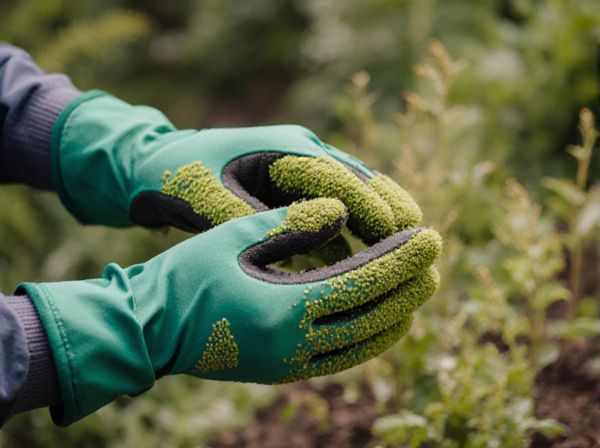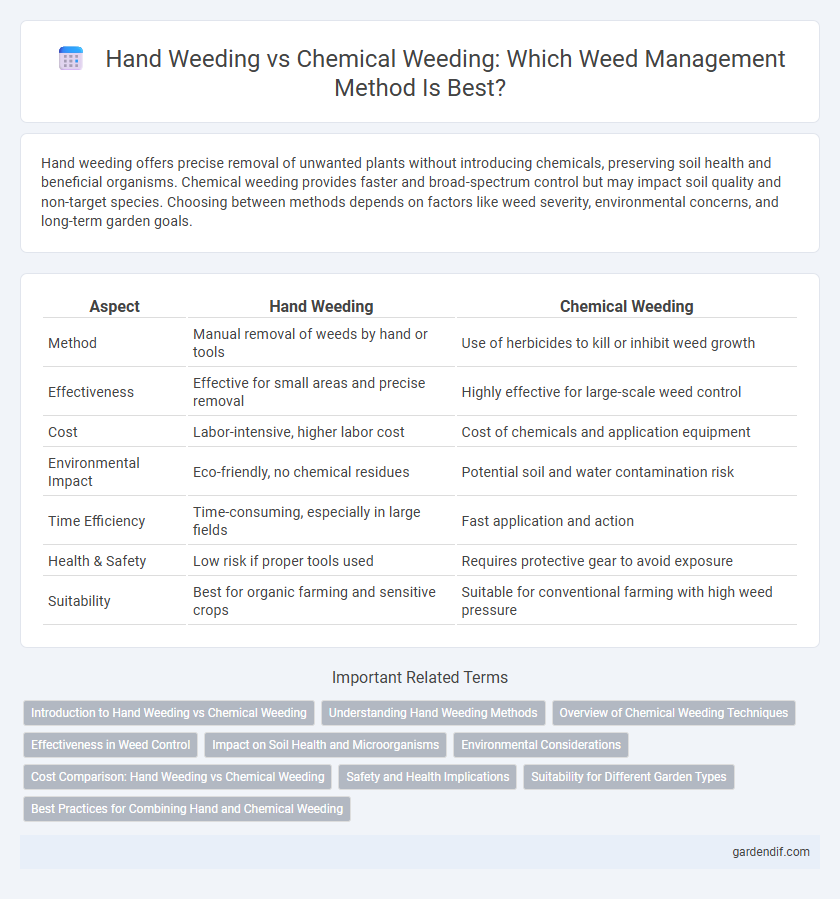
Hand Weeding vs Chemical Weeding Illustration
Hand weeding offers precise removal of unwanted plants without introducing chemicals, preserving soil health and beneficial organisms. Chemical weeding provides faster and broad-spectrum control but may impact soil quality and non-target species. Choosing between methods depends on factors like weed severity, environmental concerns, and long-term garden goals.
Table of Comparison
| Aspect | Hand Weeding | Chemical Weeding |
|---|---|---|
| Method | Manual removal of weeds by hand or tools | Use of herbicides to kill or inhibit weed growth |
| Effectiveness | Effective for small areas and precise removal | Highly effective for large-scale weed control |
| Cost | Labor-intensive, higher labor cost | Cost of chemicals and application equipment |
| Environmental Impact | Eco-friendly, no chemical residues | Potential soil and water contamination risk |
| Time Efficiency | Time-consuming, especially in large fields | Fast application and action |
| Health & Safety | Low risk if proper tools used | Requires protective gear to avoid exposure |
| Suitability | Best for organic farming and sensitive crops | Suitable for conventional farming with high weed pressure |
Introduction to Hand Weeding vs Chemical Weeding
Hand weeding involves manually removing weeds by hand or using simple tools, offering precise control and reducing chemical residues in soil and crops. Chemical weeding uses herbicides to target and eliminate weeds efficiently over large areas, often saving time and labor but potentially impacting environmental and soil health. Choosing between hand and chemical weeding depends on crop sensitivity, weed type, labor availability, and sustainability goals.
Understanding Hand Weeding Methods
Hand weeding involves physically removing weeds by uprooting them, using tools such as hoes, hand forks, or fingers to target individual plants with precision. This method reduces chemical use, preserving soil health and beneficial microorganisms while offering immediate control over weed growth. Effective hand weeding requires consistent effort, knowledge of weed species, and timing to prevent seed dispersal and ensure long-term weed management.
Overview of Chemical Weeding Techniques
Chemical weeding techniques primarily involve the application of herbicides designed to target specific weed species while minimizing damage to crops. Common methods include pre-emergent herbicides that prevent weed seed germination and post-emergent herbicides that eliminate actively growing weeds. Advances in formulation, such as selective and systemic herbicides, enhance the efficiency and environmental safety of chemical weed management in agricultural systems.
Effectiveness in Weed Control
Hand weeding offers precise removal of weeds, minimizing damage to crops and reducing chemical exposure, but is labor-intensive and less practical for large-scale infestations. Chemical weeding provides rapid and broader-spectrum control, effectively targeting diverse weed species and reducing labor costs, though it carries risks of herbicide resistance and environmental impact. Optimal weed control often combines hand weeding for localized patches with selective herbicide use to maximize effectiveness and sustainability.
Impact on Soil Health and Microorganisms
Hand weeding preserves soil health by minimizing disturbance to soil structure and maintaining a diverse microbial population essential for nutrient cycling and plant growth. Chemical weeding often disrupts microbial communities, reducing beneficial bacteria and fungi, which can lead to decreased soil fertility and increased vulnerability to soil-borne diseases. Soil impacted by chemical herbicides frequently shows lower organic matter decomposition rates and altered microbial enzyme activities, negatively affecting overall soil ecosystem functions.
Environmental Considerations
Hand weeding minimizes environmental impact by avoiding chemical use, preserving soil health and benefiting local biodiversity. Chemical weeding, while efficient, can introduce harmful herbicides that contaminate water sources and disrupt ecosystems. Sustainable weed management prioritizes methods that balance effectiveness with environmental protection.
Cost Comparison: Hand Weeding vs Chemical Weeding
Hand weeding generally incurs higher labor costs due to the intensive manual effort required, especially on large-scale farms, while chemical weeding demands upfront investment in herbicides and application equipment but reduces ongoing labor expenses. Chemical weeding offers cost efficiency in terms of time and scalability, particularly when managing extensive weed infestations, whereas hand weeding remains economically viable for small plots or organic farming where chemical use is restricted. The overall cost comparison heavily depends on factors such as farm size, weed density, labor availability, and herbicide prices, influencing the choice between these weed control methods.
Safety and Health Implications
Hand weeding minimizes exposure to harmful chemicals, reducing the risk of respiratory issues and skin irritations commonly associated with chemical herbicides. Chemical weeding, while efficient, poses potential health hazards such as pesticide poisoning and long-term chronic illnesses due to toxic residue. Prioritizing hand weeding or using organic herbicides can significantly enhance safety and promote a healthier environment for farmworkers and consumers.
Suitability for Different Garden Types
Hand weeding is ideal for small-scale gardens, organic and vegetable patches where precision and minimal disturbance to surrounding plants are crucial. Chemical weeding suits larger landscapes and lawns, offering efficient control of extensive weed populations with faster results. Selecting the appropriate method depends on garden size, plant sensitivity, and environmental considerations.
Best Practices for Combining Hand and Chemical Weeding
Integrating hand weeding with chemical weeding enhances weed control efficacy by targeting diverse weed species and growth stages. Best practices include using selective herbicides to minimize crop damage, applying chemicals during early weed growth, and following up with hand weeding to remove resistant or escaped weeds. This combined approach reduces herbicide reliance, promotes sustainable agriculture, and improves overall crop yield and soil health.
Hand Weeding vs Chemical Weeding Infographic

 gardendif.com
gardendif.com